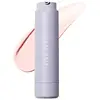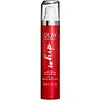What's inside
What's inside
 Key Ingredients
Key Ingredients

 Benefits
Benefits

 Concerns
Concerns

 Ingredients Side-by-side
Ingredients Side-by-side

Zinc Oxide 15.5%
Cosmetic ColorantWater
Skin ConditioningC12-15 Alkyl Benzoate
AntimicrobialCaprylic/Capric Triglyceride
MaskingButyloctyl Salicylate
Skin ConditioningDimethicone
EmollientGlycerin
HumectantEthylhexyl Palmitate
EmollientPropanediol
SolventButyrospermum Parkii Butter
Skin ConditioningCarthamus Tinctorius Oleosomes
EmollientGlyceryl Stearate Se
EmulsifyingButylene Glycol
HumectantPolyhydroxystearic Acid
EmulsifyingSorbitan Isostearate
EmulsifyingCetyl Alcohol
EmollientNiacinamide
SmoothingPentaerythrityl Tetraisostearate
EmollientPhenyl Trimethicone
Skin ConditioningSilica
AbrasiveHyaluronic Acid
HumectantSodium Hyaluronate
HumectantCitrullus Lanatus Seed Extract
Skin ConditioningAdansonia Digitata Pulp Extract
EmollientBarosma Betulina Leaf Extract
PerfumingAloe Barbadensis Leaf Juice
Skin ConditioningTocopherol
AntioxidantGluconolactone
Skin ConditioningInulin Lauryl Carbamate
Emulsion StabilisingHydroxyethyl Acrylate/Sodium Acryloyldimethyl Taurate Copolymer
Emulsion StabilisingXanthan Gum
EmulsifyingHydroxyacetophenone
AntioxidantPolysilicone-11
Trisodium Ethylenediamine Disuccinate
Sodium Citrate
BufferingCitric Acid
BufferingBenzyl Salicylate
PerfumingEthylhexylglycerin
Skin ConditioningSodium Benzoate
MaskingPotassium Sorbate
PreservativePhenoxyethanol
PreservativeParfum
MaskingHexyl Cinnamal
PerfumingLimonene
PerfumingLinalool
PerfumingCI 15985
Cosmetic ColorantCI 17200
Cosmetic ColorantZinc Oxide 15.5%, Water, C12-15 Alkyl Benzoate, Caprylic/Capric Triglyceride, Butyloctyl Salicylate, Dimethicone, Glycerin, Ethylhexyl Palmitate, Propanediol, Butyrospermum Parkii Butter, Carthamus Tinctorius Oleosomes, Glyceryl Stearate Se, Butylene Glycol, Polyhydroxystearic Acid, Sorbitan Isostearate, Cetyl Alcohol, Niacinamide, Pentaerythrityl Tetraisostearate, Phenyl Trimethicone, Silica, Hyaluronic Acid, Sodium Hyaluronate, Citrullus Lanatus Seed Extract, Adansonia Digitata Pulp Extract, Barosma Betulina Leaf Extract, Aloe Barbadensis Leaf Juice, Tocopherol, Gluconolactone, Inulin Lauryl Carbamate, Hydroxyethyl Acrylate/Sodium Acryloyldimethyl Taurate Copolymer, Xanthan Gum, Hydroxyacetophenone, Polysilicone-11, Trisodium Ethylenediamine Disuccinate, Sodium Citrate, Citric Acid, Benzyl Salicylate, Ethylhexylglycerin, Sodium Benzoate, Potassium Sorbate, Phenoxyethanol, Parfum, Hexyl Cinnamal, Limonene, Linalool, CI 15985, CI 17200
Butyl Methoxydibenzoylmethane 3%
UV AbsorberHomosalate 10%
Skin ConditioningEthylhexyl Salicylate 5%
UV AbsorberOctocrylene 9%
UV AbsorberWater
Skin ConditioningTapioca Starch
Glycerin
HumectantNiacinamide
SmoothingDimethicone
EmollientPanthenol
Skin ConditioningSodium Polyacrylate Starch
AbsorbentStearyl Alcohol
EmollientPEG-100 Stearate
Caprylyl Glycol
Emollient1,2-Hexanediol
Skin ConditioningPhenoxyethanol
PreservativeCetyl Alcohol
EmollientBehenyl Alcohol
EmollientDimethiconol
EmollientCetearyl Glucoside
EmulsifyingCetearyl Alcohol
EmollientPolymethylsilsesquioxane
Parfum
MaskingStearic Acid
CleansingPalmitic Acid
EmollientDisodium EDTA
Sodium Hyaluronate
HumectantPalmitoyl Pentapeptide-4
Skin ConditioningCeratonia Siliqua Fruit Extract
MaskingButyl Methoxydibenzoylmethane 3%, Homosalate 10%, Ethylhexyl Salicylate 5%, Octocrylene 9%, Water, Tapioca Starch, Glycerin, Niacinamide, Dimethicone, Panthenol, Sodium Polyacrylate Starch, Stearyl Alcohol, PEG-100 Stearate, Caprylyl Glycol, 1,2-Hexanediol, Phenoxyethanol, Cetyl Alcohol, Behenyl Alcohol, Dimethiconol, Cetearyl Glucoside, Cetearyl Alcohol, Polymethylsilsesquioxane, Parfum, Stearic Acid, Palmitic Acid, Disodium EDTA, Sodium Hyaluronate, Palmitoyl Pentapeptide-4, Ceratonia Siliqua Fruit Extract
Ingredients Explained
These ingredients are found in both products.
Ingredients higher up in an ingredient list are typically present in a larger amount.
Cetyl Alcohol is a fatty alcohol. Fatty Alcohols are most often used as an emollient or to thicken a product.
Its main roles are:
Though it has "alcohol" in the name, it is not related to denatured alcohol or ethyl alcohol.
The FDA allows products labeled "alcohol-free" to have fatty alcohols.
Learn more about Cetyl AlcoholDimethicone is a type of synthetic silicone created from natural materials such as quartz.
What it does:
Dimethicone comes in different viscosities:
Depending on the viscosity, dimethicone has different properties.
Ingredients lists don't always show which type is used, so we recommend reaching out to the brand if you have questions about the viscosity.
This ingredient is unlikely to cause irritation because it does not get absorbed into skin. However, people with silicone allergies should be careful about using this ingredient.
Note: Dimethicone may contribute to pilling. This is because it is not oil or water soluble, so pilling may occur when layered with products. When mixed with heavy oils in a formula, the outcome is also quite greasy.
Learn more about DimethiconeGlycerin is already naturally found in your skin. It helps moisturize and protect your skin.
A study from 2016 found glycerin to be more effective as a humectant than AHAs and hyaluronic acid.
As a humectant, it helps the skin stay hydrated by pulling moisture to your skin. The low molecular weight of glycerin allows it to pull moisture into the deeper layers of your skin.
Hydrated skin improves your skin barrier; Your skin barrier helps protect against irritants and bacteria.
Glycerin has also been found to have antimicrobial and antiviral properties. Due to these properties, glycerin is often used in wound and burn treatments.
In cosmetics, glycerin is usually derived from plants such as soybean or palm. However, it can also be sourced from animals, such as tallow or animal fat.
This ingredient is organic, colorless, odorless, and non-toxic.
Glycerin is the name for this ingredient in American English. British English uses Glycerol/Glycerine.
Learn more about GlycerinNiacinamide is a multitasking form of vitamin B3 that strengthens the skin barrier, reduces pores and dark spots, regulates oil, and improves signs of aging.
And the best part? It's gentle and well-tolerated by most skin types, including sensitive and reactive skin.
You might have heard of "niacin flush", or the reddening of skin that causes itchiness. Niacinamide has not been found to cause this.
In very rare cases, some individuals may not be able to tolerate niacinamide at all or experience an allergic reaction to it.
If you are experiencing flaking, irritation, and dryness with this ingredient, be sure to double check all your products as this ingredient can be found in all categories of skincare.
When incorporating niacinamide into your routine, look out for concentration amounts. Typically, 5% niacinamide provides benefits such as fading dark spots. However, if you have sensitive skin, it is better to begin with a smaller concentration.
When you apply niacinamide to your skin, your body converts it into nicotinamide adenine dinucleotide (NAD). NAD is an essential coenzyme that is already found in your cells as "fuel" and powers countless biological processes.
In your skin, NAD helps repair cell damage, produce new healthy cells, support collagen production, strengthen the skin barrier, and fight environmental stressors (like UV and pollution).
Our natural NAD levels start to decline with age, leading to slower skin repair, visible aging, and a weaker skin barrier. By providing your skin niacinamide, you're recharging your skin's NAD levels. This leads to stronger, healthier, and younger looking skin.
Another name for vitamin B3 is nicotinamide. This vitamin is water-soluble and our bodies don't store it. We obtain Vitamin B3 from either food or skincare. Meat, fish, wheat, yeast, and leafy greens contain vitamin B3.
The type of niacinamide used in skincare is synthetically created.
Learn more about NiacinamideParfum is a catch-all term for an ingredient or more that is used to give a scent to products.
Also called "fragrance", this ingredient can be a blend of hundreds of chemicals or plant oils. This means every product with "fragrance" or "parfum" in the ingredients list is a different mixture.
For instance, Habanolide is a proprietary trade name for a specific aroma chemical. When used as a fragrance ingredient in cosmetics, most aroma chemicals fall under the broad labeling category of “FRAGRANCE” or “PARFUM” according to EU and US regulations.
The term 'parfum' or 'fragrance' is not regulated in many countries. In many cases, it is up to the brand to define this term.
For instance, many brands choose to label themselves as "fragrance-free" because they are not using synthetic fragrances. However, their products may still contain ingredients such as essential oils that are considered a fragrance by INCI standards.
One example is Calendula flower extract. Calendula is an essential oil that still imparts a scent or 'fragrance'.
Depending on the blend, the ingredients in the mixture can cause allergies and sensitivities on the skin. Some ingredients that are known EU allergens include linalool and citronellol.
Parfum can also be used to mask or cover an unpleasant scent.
The bottom line is: not all fragrances/parfum/ingredients are created equally. If you are worried about fragrances, we recommend taking a closer look at an ingredient. And of course, we always recommend speaking with a professional.
Learn more about ParfumPhenoxyethanol is a preservative that has germicide, antimicrobial, and aromatic properties. Studies show that phenoxyethanol can prevent microbial growth. By itself, it has a scent that is similar to that of a rose.
It's often used in formulations along with Caprylyl Glycol to preserve the shelf life of products.
Sodium Hyaluronate is hyaluronic acid's salt form. It is commonly derived from the sodium salt of hyaluronic acid.
Like hyaluronic acid, it is great at holding water and acts as a humectant. This makes it a great skin hydrating ingredient.
Sodium Hyaluronate is naturally occurring in our bodies and is mostly found in eye fluid and joints.
These are some other common types of Hyaluronic Acid:
Learn more about Sodium HyaluronateWater. It's the most common cosmetic ingredient of all. You'll usually see it at the top of ingredient lists, meaning that it makes up the largest part of the product.
So why is it so popular? Water most often acts as a solvent - this means that it helps dissolve other ingredients into the formulation.
You'll also recognize water as that liquid we all need to stay alive. If you see this, drink a glass of water. Stay hydrated!
Learn more about Water